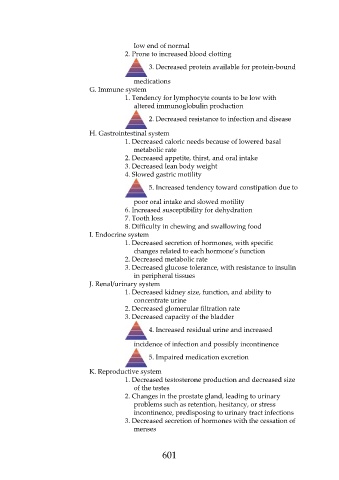Page 601 - Saunders Comprehensive Review For NCLEX-RN
P. 601
low end of normal
2. Prone to increased blood clotting
3. Decreased protein available for protein-bound
medications
G. Immune system
1. Tendency for lymphocyte counts to be low with
altered immunoglobulin production
2. Decreased resistance to infection and disease
H. Gastrointestinal system
1. Decreased caloric needs because of lowered basal
metabolic rate
2. Decreased appetite, thirst, and oral intake
3. Decreased lean body weight
4. Slowed gastric motility
5. Increased tendency toward constipation due to
poor oral intake and slowed motility
6. Increased susceptibility for dehydration
7. Tooth loss
8. Difficulty in chewing and swallowing food
I. Endocrine system
1. Decreased secretion of hormones, with specific
changes related to each hormone’s function
2. Decreased metabolic rate
3. Decreased glucose tolerance, with resistance to insulin
in peripheral tissues
J. Renal/urinary system
1. Decreased kidney size, function, and ability to
concentrate urine
2. Decreased glomerular filtration rate
3. Decreased capacity of the bladder
4. Increased residual urine and increased
incidence of infection and possibly incontinence
5. Impaired medication excretion
K. Reproductive system
1. Decreased testosterone production and decreased size
of the testes
2. Changes in the prostate gland, leading to urinary
problems such as retention, hesitancy, or stress
incontinence, predisposing to urinary tract infections
3. Decreased secretion of hormones with the cessation of
menses
601

